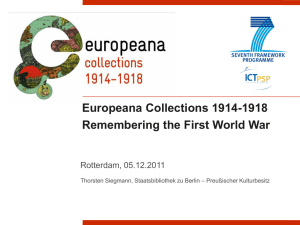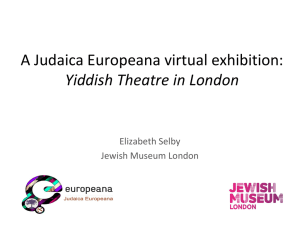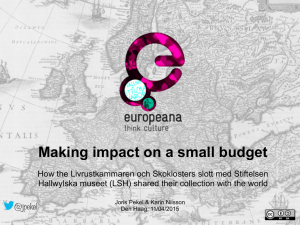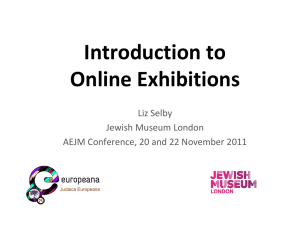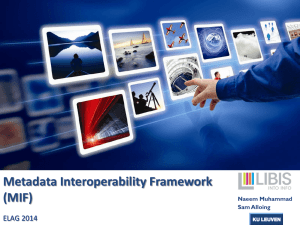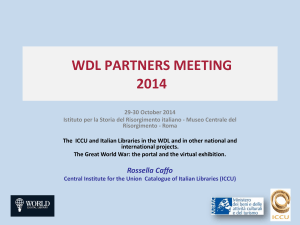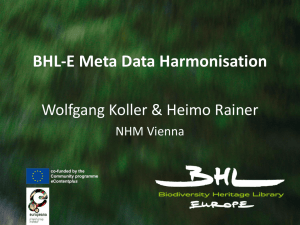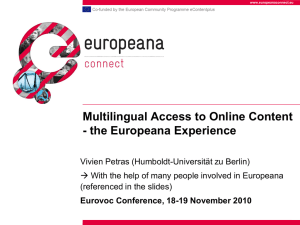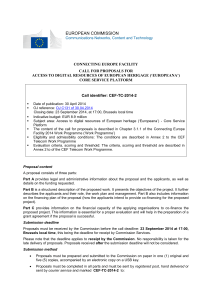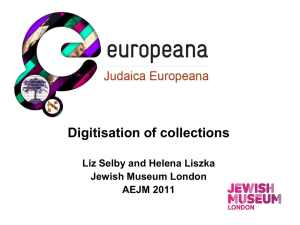Final Project Presentation
advertisement
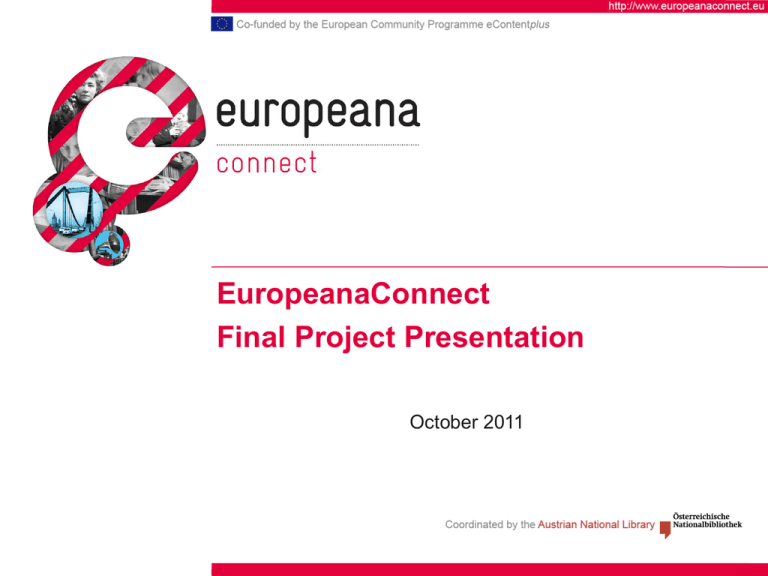
EuropeanaConnect Final Project Presentation October 2011 Contents of presentation • Background: Europeana and related projects • What is EuropeanaConnect • Objectives • Partners • Specific content to be contributed to Europeana • Structure • Achievements Europeana Europeana: the vision ‘A digital library that is a single, direct and multilingual access point to the European cultural heritage.’ European Parliament, 27 September 2007 ‘A unique resource for Europe's distributed cultural heritage… ensuring a common access to Europe's libraries, archives and museums.’ Horst Forster, Former Director, Digital Content & Cognitive Systems Information Society Directorate, European Commission www.europeana.eu: Content • 20 million items are now accessible: • 13,5 million images: photos, paintings, drawings, postcards, posters • 6 million texts: books, newspapers, manuscripts, letters • 145,900 videos: film, documentary, TV broadcasts, public information • 306,300 sounds: cylinders, 78rpm discs, radio, field recordings Europeana is governed by Europeana Foundation and supported by CENL . About • “Best Practice Network” • Co-funded by EC in the eContentplus programme • Duration May 2009 – October 2011 (= 2,5 years) • 30 project partners from 14 countries • Coordinated by Austrian National Library • ~ 900 Person Months total labour effort • Total budget: • 80 % EU funding: 5.625.000 Euro 4.500.000 Euro Key Objectives 1. Provide a critical mass of audio content to Europeana and implement an audio-enabling infrastructure 2. Build the Semantic Layer for Europeana 3. Facilitate multilingual access to Europeana 4. Develop novel access channels to Europeana (like mobile access) 5. Provide tools and methodologies for user-driven development and for testing and evaluation 6. Build value-added services (like e-Books-on-Demand) 7. Implement key infrastructure components (like OAI-PMH infrastructure) 8. Build the Europeana Licensing Framework 9. Enable stronger and wider collaborative networking Partner Institutions • Europeana Foundation, The Hague • 10 Universities and Academies of Sciences: • 8 Libraries: • Austrian National Library (Coordinator) • Royal Library of Denmark • National Library of Luxembourg • National Library of the Netherlands • Innsbruck University Library • Göttingen State and University Library • German National Library • National Library of Portugal • • • • • • • • • • Humboldt University Berlin University of Vienna Instituto Superior Técnico, Lisbon VU University Amsterdam National Technical University of Athens University of Amsterdam University of Padua Polish Academy of Sciences Hungarian Academy of Sciences Slovenian Academy of Sciences Partner Institutions 7 Research Institutes: • OFFIS Institute for Information Technology, DE • XEROX SAS, FR • CELI S.R.L., IT • Knowledgeland, NL • University College London Consultants Ltd, UK • Austrian Institute of Technology GmbH, AT • AIT Applied Information Technology ltd., AT • 1 Broadcast Company: • Rundfunk Berlin-Brandenburg, DE • 1 Publishing House: • Amsterdam University Press, NL • 1 Institute for Literature: • Institute of Lithuanian Literature and Folklore, LT • 1 Consultant Company: • Eremo s.r.l., IT Specific content contributed to Europeana • EuropeanaConnect added a critical mass of audio content to Europeana and • Implemented an audio-aggregation infrastructure to harvest audio from hundreds of audio archives • By the close of EuropeanaConnect approximately 350,000 items had been harvested by Europeana Work Structure Work Package 1: Creating the Europeana Semantic Layer WP Lead: Humboldt-Universität zu Berlin, DE • Semantic Data Layer Creation • Aligning the Semantic Data • Workflow Automation • Functional Specifications for Semantics Based Operations • Testing and Evaluation • Networking and Clustering Activities Work Package 2: Multilingual Access to Content WP Lead: Humboldt-Universität zu Berlin, DE • User studies and evaluation of multilingual resources use • Europeana Language Resources Repository • Tools for multilingual mapping of controlled vocabularies and subject metadata • Translation modules for Europeana • Testing and evaluation of translation modules • Integration with Europeana retrieval framework • Dissemination & Exchange of multilingual access strategies for digital libraries Work Package 3: User Driven Development and New Access Channels WP Lead: The Royal Library, DK • Log analysis for future user-driven development • Methodologies and tools for user involvement • Spatio-temporal access channels for Europeana • Mobile Access Channels for Europeana Work Package 4: Europeana Licensing Framework WP Lead: National Library of Luxembourg, LU • Recommendations for a core Europeana Licensing Framework and validation thereof • Creating tools for the Europeana Licensing Framework • Evaluation and testing of the tools and proof of concept • Deployment in Europeana Work Package 5: Enabling and Integrating Services for Europeana WP Lead: Austrian Institute of Technology GmbH, AT • Europeana Metadata Registry • Europeana Service Registry • Europeana OAI-PMH Management Infrastructure • Europeana Resolution Discovery Service for Persistent Identifiers • Geographical Information Services • Multimedia Annotation Services • “eBooks on Demand” (EOD) Service • User Testing, Evaluation and Assessment of the Services • Cross-project Networking and Clustering Work Package 6: Audio Aggregation WP Lead: Rundfunk Berlin-Brandenburg, DE • Audio content aggregation, themes coordination • Extension of the network to include new content providers • Metadata harmonisation and data enrichment • Content management tools, IPR • Training activities and support • Pilots, Testing & Evaluation Work Package 7: Dissemination and Concertation WP Lead: EREMO S.R.L., IT • Dissemination of project results • Dissemination tools (website, project presentation, posters, fact sheet, press releases, etc.) • Concertation with Europeana v1.0 • Concertation with EU activities Work Package 8: Project Management WP Lead: Österreichische Nationalbibliothek, AT • Financial coordination • Internal consortium management and coordination • Overall monitoring • Liaison with the Commission • Evaluation and Quality control Achievements Adding music audio to Europeana • About 350,000 audio items were made available through Europeana via the DISMARC-EuropeanaConnect Audio Aggregation Platform • A virtual Audio Exhibition was developed (http://econnect.ait.co.at/wedding-exhibition/) (http://exhibitions.europeana.eu/exhibits/show/weddings-in-easterneurope/themes). It delivers content on 'Weddings in Eastern Europe' and includes audio, text, images and video • The Audio Aggregation Platform can be fully or partly deployed on a ‘virtual machine’ which requires only a computer system with an internet connection • Set of tools for content management developed • Enable content owners to manage their data online and allow users to add their own comments about particular pieces of music Audio Aggregation Platform Virtual exhibition Building the Europeana Semantic Layer • Survey of controlled and structured vocabularies among Europeana data providers • • • • carried out Selected vocabularies successfully migrated to SKOS Specification of semantic functionality created and checked with selected expert users A substantial contribution was made to the Europeana Data Model (EDM), assisting with its specification and stabilisation A semantic layer prototype running AMALGAME was developed: http://semanticweb.cs.vu.nl/europeana/. Tool documentation is available at http://semanticweb.cs.vu.nl/amalgame/. Multilingual Access to Europeana • Report on user preferences and information retrieval scenarios for multilingual access in Europeana produced • Specification for the Europeana language resources repository developed • Multilingual mapping of controlled vocabularies was carried out with an exploration of available resources • A query translation module for all 10 EuropeanaConnect languages (translating from any of the 10 languages into any of the 10 languages) was developed and evaluated. Understanding User Needs / New Access Channels • Developed a methodology for understanding what users do when they visit Europeana (aimed to improve their experience) • Carried out log-file analysis and developed a personas catalogue as a tool for user evaluation • Developed a protoype of a spatio-temporal interface to enable users to explore Europeana by time and location • Developed and included in Europeana a generic mobile client, adapting to the user‘s mobile, allowing to search the Europeana database from a mobile device Mobile client allowing searching Europeana via a mobile device Europeana Licensing Framework KEY RESULTS: • Contracts regulating the re-use of descriptive metadata: An initial set of Europeana Data Provider and Data Aggregator Agreements (http://www.europeana-libraries.eu/web/europeanaproject/newagreement/) governing relationships between Europeana and its partners • Europeana Public Domain Charter: http://version1.europeana.eu/web/europeana-project/publications • A Public Domain Calculator” http://www.outofcopyright.eu was developed • “Terms of use for User Generated Content”, deployed in a key pilot: the 1914-1918 collection: http://www.europeana19141918.eu/en/about/terms Integrating software and services in Europeana • Geographical Information Services (GIS) suite developed to enrich Europeana • • • • • metadata and content with explicit geographical metadata and references Universal Multimedia Annotator suite to provide Europeana with annotation capabilities for audio and video content, images and maps. On-line media annotation suite, available at: http://dme.arcs.ac.at/annotation/ Evaluation platform (COMPASS) for the Map Annotation Tool developed: http://compass.cs.univie.ac.at/ EoD (eBook-on-Demand) Service, (http://books2ebooks.eu/) network was significantly extended and a connector was produced to allow Europeana to harvest metadata of already digitised books The REPOX software was developed to automate the process of adding content to Europeana The Europeana Resolution Discovery Service (ERDS) was developed to challenge the persistent identification of digital objects across different resolution services in use by cultural heritage institutions. Dissemination and Concertation • Project web site: www.europeanaconnect.eu • Dissemination materials (brochures, fact-sheet, poster, ppt, etc.) • Continuous concertation with Europeana • All resources and public project results from http://www.europeanaconnect.eu/results-and-resources.php • EuropeanaTech (Final Project Conference) new project web site: http://www.europeanaconnect.eu/europeanatech/ THANK YOU
